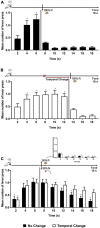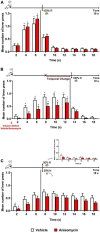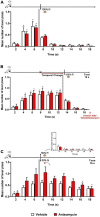Temporal prediction error triggers amygdala-dependent memory updating in appetitive operant conditioning in rats
- PMID: 36703723
- PMCID: PMC9873233
- DOI: 10.3389/fnbeh.2022.1060587
Temporal prediction error triggers amygdala-dependent memory updating in appetitive operant conditioning in rats
Abstract
Reinforcement learning theories postulate that prediction error, i.e., a discrepancy between the actual and expected outcomes, drives reconsolidation and new learning, inducing an updating of the initial memory. Pavlovian studies have shown that prediction error detection is a fundamental mechanism in triggering amygdala-dependent memory updating, where the temporal relationship between stimuli plays a critical role. However, in contrast to the well-established findings in aversive situations (e.g., fear conditioning), only few studies exist on prediction error in appetitive operant conditioning, and even less with regard to the role of temporal parameters. To explore if temporal prediction error in an appetitive operant paradigm could generate an updating and consequent reconsolidation and/or new learning of temporal association, we ran four experiments in adult male rats. Experiment 1 verified whether an unexpected delay in the time of reward's availability (i.e., a negative temporal prediction error) in a single session produces an updating in long-term memory of temporal expectancy in an appetitive operant conditioning. Experiment 2 showed that negative prediction errors, either due to the temporal change or through reward omission, increased in the basolateral amygdala nucleus (BLA) the activation of a protein that is critical for memory formation. Experiment 3 revealed that the presence of a protein synthesis inhibitor (anisomycin) in the BLA during the session when the reward was delayed (Error session) affected the temporal updating. Finally, Experiment 4 showed that anisomycin, when infused immediately after the Error session, interfered with the long-term memory of the temporal updating. Together, our study demonstrated an involvement of BLA after a change in temporal and reward contingencies, and in the resulting updating in long-term memory in appetitive operant conditioning.
Keywords: basolateral amygdala; negative prediction error; omission effect; reconsolidation; timing.
Copyright © 2023 Tavares, Bueno and Doyère.
Conflict of interest statement
The authors declare that the research was conducted in the absence of any commercial or financial relationships that could be construed as a potential conflict of interest.
Figures




Similar articles
-
The Human Centromedial Amygdala Contributes to Negative Prediction Error Signaling during Appetitive and Aversive Pavlovian Gustatory Learning.J Neurosci. 2023 Apr 26;43(17):3176-3185. doi: 10.1523/JNEUROSCI.0926-22.2023. Epub 2023 Mar 24. J Neurosci. 2023. PMID: 36963846 Free PMC article.
-
Differential effect of beta-adrenergic receptor antagonism in basolateral amygdala on reconsolidation of aversive and appetitive memories associated with morphine in rats.Addict Biol. 2014 Jan;19(1):5-15. doi: 10.1111/j.1369-1600.2012.00443.x. Epub 2012 Mar 28. Addict Biol. 2014. PMID: 22458530
-
Updating appetitive memory during reconsolidation window: critical role of cue-directed behavior and amygdala central nucleus.Front Behav Neurosci. 2013 Dec 9;7:186. doi: 10.3389/fnbeh.2013.00186. eCollection 2013. Front Behav Neurosci. 2013. PMID: 24367304 Free PMC article.
-
Updating memories--the role of prediction errors in memory reconsolidation.Behav Brain Res. 2015 Feb 1;278:375-84. doi: 10.1016/j.bbr.2014.10.011. Epub 2014 Oct 22. Behav Brain Res. 2015. PMID: 25453746 Review.
-
Neural substrates of appetitive and aversive prediction error.Neurosci Biobehav Rev. 2021 Apr;123:337-351. doi: 10.1016/j.neubiorev.2020.10.029. Epub 2021 Jan 13. Neurosci Biobehav Rev. 2021. PMID: 33453307 Free PMC article. Review.
Cited by
-
Temporal recalibration in response to delayed visual feedback of active versus passive actions: an fMRI study.Sci Rep. 2024 Feb 26;14(1):4632. doi: 10.1038/s41598-024-54660-2. Sci Rep. 2024. PMID: 38409306 Free PMC article.
References
LinkOut - more resources
Full Text Sources
Miscellaneous

